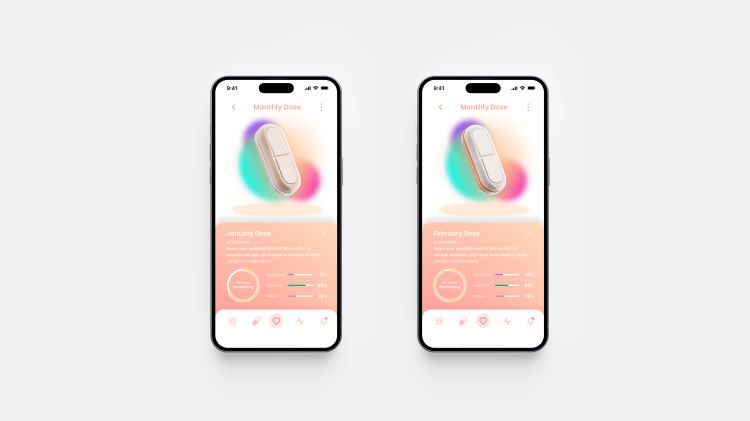AI and 3D-printed pills: Morrama’s new menopause concept

by IBRAHIM
AI and 3D-printed pills: Morrama’s new menopause concept

Morrama founder Jo Barnard explains the studio’s latest concept, which uses a data-driven app and 3D printing to create tailored supplements for menopause.
Morrama has devised a menopause management app concept called Luma as part of a self-initiated project, involving AI technology and 3D-printed pills.
Research for the design began in October 2022 after launching the studio’s think-tank Morrama Lab. Morrama founder Jo Barnard says that although there has been more conversation around menopause in recent years, there is still “not enough done and not enough talked about” in this space.
Barnard explains that in January, the government rejected a bill that would have allowed women experiencing debilitating symptoms of menopause to take leave from work. This speaks to the fact that few “key decision-makers in business” are going through menopause, as senior positions in most sectors are still male-dominated, according to Barnard.
“Not just a switch that gets flipped”
Morrama’s Luma concept is designed to pick up data such as spikes in heart rate, temperature fluctuations, sleep patterns and increased stress. While users would be able to input data manually by answering questions, Morrama intends for the app to be low maintenance, using a smartwatch to more easily supply accurate data.
Once the data is compiled, supplements are tailored to the user using a unique balance of three natural ingredients. Then they are automatically 3D printed and shipped to the user on a monthly basis in a package that fits through the post box.
Morrama envisions using a new “cellulose-based, biodegradable” blister pack being developed by company called PulPac, says Barnard. An optional refill pot would make the service “as plastic-free and sustainable as possible”, she adds.
Barnard describes the menopause as “something you go through, not just a switch that gets flipped”. Users would first receive a more general combination of the ingredients, but as symptoms change and the app collects more data each month, so would the dosage of the supplement ingredients. If symptoms persist, the AI technology could automatically increase the dose and send the information to the 3D printer.
“The biggest challenge”
With services like Luma, making it low-cost and automated is “the biggest challenge”, says Barnard. She adds that “more tailored services like this are going to happen” and that 3D printing is the way forward, as it opens up the possibility to make small batches for tailored medications, rather than requiring minimum orders of five to ten thousand tablets.
“When we think of 3D printing, we often think of plastics. This is essentially the same thing” but with different materials, says Barnard.
Three nozzles containing the ingredients would layer the correct ratio of each, depending on the user’s symptoms. The ingredients would need to be mixed with a carrier, like a gel, making them malleable for 3D printing.
“Drawing on the power of plants”
“Some women are more than happy to take hormones which are often recommended by doctors, but some are uncomfortable with pumping their body full of hormones every day, potentially for a decade”, says Barnard. She adds that there has been a general move towards “finding more natural remedies” in recent years.
Morrama’s suggested ingredients are already used to treat menopause – some for thousands of years – with each of them “drawing on the power of plants”.
The unique compound would include a combination of Black Cohosh, which helps with managing hot flushes, Lion’s Mane to help reduce brain fog and Ginseng which aims to increase libido. Where legal, the studio has also considered using THC, “which mimics aspects of anandamide, an endocannabinoid that helps regulate body temperature”, says Barnard.
“Unobtrusive but intuitive”
Luma was created for a specific demographic – usually women aged 45-55 – and the app aims to be accessible for all technical abilities. Barnard says that Morrama has designed quite a lot of the app, which is supposed to be “unobtrusive but intuitive”.
As well as access to a built-in forum, the app would provide users with information about symptom management and the supplement ingredients. Barnard says the aim is to be “transparent” about what users are putting into their bodies.
Barnard says there is a benefit to making the app feel “trustworthy” through its visual identity, so it says it might be best to avoid “a hip start-up vibe”. Currently the concept has a “deliberate lack of identity” and absence of “company feel” so it can be easily adapted to whichever brand takes it on and invests in it, Barnard explains.
“First in the market”
While supplements for menopause do exist, there is not currently anything that can be tailored to the individual. Barnard describes Luma as an opportunity for a company to be “the first in the market to do it”.
She says that the “agile nature” of the concept makes it prime for a “smaller tech-focused start-up” as it could start with 50 users and doesn’t require any mass production.
Recommended Posts

NB invites local designers centre stage for Vineyard Theatre rebrand
February 24, 2023

“AI revolution” will change way design studios look within three years
February 24, 2023

Rbl rebrands ZSL with ecosystem-inspired identity
February 23, 2023

